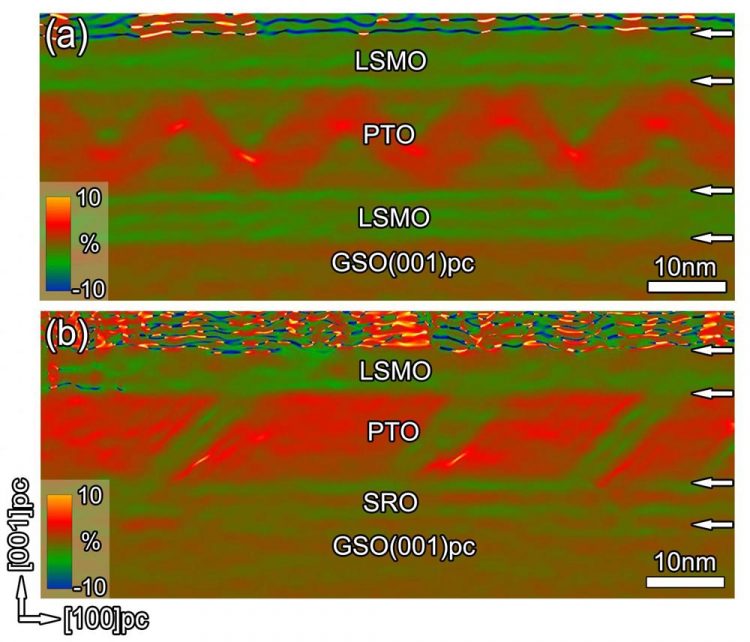Ferroelectric phenomenon proven viable for oxide electrodes, disproving predictions

(a) FCD domains in the PTO layer with symmetric oxide electrodes. (b) Alternating current domains in the PTO layer with asymmetric oxide electrodes. Credit: Shuang Li and Yinlian Zhu
Flux-closure domain (FCD) structures are microscopic topological phenomena found in ferroelectric thin films that feature distinct electric polarization properties. These closed-loop domains have garnered attention among researchers studying new ferroelectric devices, ranging from data storage components and spintronic tunnel junctions to ultra-thin capacitors.
In the development of thin films for such devices, researchers have thought that contact with commonly used oxide electrodes limits FCD formation. However, a group of researchers in China has shown otherwise. The findings are reported this week as the cover article in Applied Physics Letters, from AIP Publishing.
Ferroelectric materials are typically developed and studied as thin films, sometimes as thin as only a few nanometers. As a result, researchers have begun discovering the abundant domain structures and unique physical properties that these ferroelectrics possess, such as skyrmion and FCD formation that could benefit next-generation electronic devices. Because the films are so thin, however, their interaction with electrodes is inevitable.
“The general thinking has been that oxide electrodes would destabilize flux-closure domains. However, our work has shown that this is no longer true when the top and bottom electrodes are symmetric, which physically makes sense,” said Yinlian Zhu, professor at the Institute of Metal Research at the Chinese Academy of Sciences and a co-author of the paper.
Zhu and colleagues used two types of oxide electrodes: one based on strontium ruthenate, the other based on lanthanum strontium manganite, chosen as oxide electrodes because of their similar perovskite structures, which work well in layer-by-layer film growth. They studied how these electrodes influenced FCD formation in PbTiO3 (PTO) perovskite-oxide-based thin films deposited on gadolinium scandium oxide (GSO) substrates.
The research team's previous studies indicated that flux-closure domains can be stabilized in strained ferroelectric films in which the strain plays a critical role in the formation of flux-closure domains, such as multilayer PTO/strontium titanate systems grown on GSO-based (specifically GdScO3) substrates.
Based on their previous studies, the researchers consequently anticipated that similar phenomenon might also occur in PTO/electrode systems. They then grew PTO films sandwiched between symmetric oxide electrodes on GSO substrates using pulsed laser deposition.
They found that periodic FCD arrays can be stabilized in PTO films when the top and bottom electrodes are symmetric, while alternating current domains appear when they apply asymmetric electrodes.
“We successfully grew ferroelectric thin films with symmetric oxide electrodes in which flux-closure domains and their periodic arrays clearly do exist,” Zhu said. “Our work sheds light on understanding the nature of flux-closure domains in ferroelectrics. We expect that it will open research possibilities in the evolution of these structures under external electric fields.”
###
The article, “Periodic arrays of flux-closure domains in ferroelectric thin films with oxide electrodes,” is authored by S. Li, Y.L. Zhu, Y.J. Wang, Y.L. Tang, Y. Liu, S.R. Zhang, J.Y. Ma and X.L. Ma. The article appeared in Applied Physics Letters July 31, 2017 (DOI: 10.1063/1.4996232). After that date, it can be accessed at http://aip.
ABOUT THE JOURNAL
Applied Physics Letters features concise, rapid reports on significant new findings in applied physics. The journal covers new experimental and theoretical research on applications of physics phenomena related to all branches of science, engineering, and modern technology. See http://apl.
Media Contact
All latest news from the category: Physics and Astronomy
This area deals with the fundamental laws and building blocks of nature and how they interact, the properties and the behavior of matter, and research into space and time and their structures.
innovations-report provides in-depth reports and articles on subjects such as astrophysics, laser technologies, nuclear, quantum, particle and solid-state physics, nanotechnologies, planetary research and findings (Mars, Venus) and developments related to the Hubble Telescope.
Newest articles

Innovative vortex beam technology
…unleashes ultra-secure, high-capacity data transmission. Scientists have developed a breakthrough optical technology that could dramatically enhance the capacity and security of data transmission (Fig. 1). By utilizing a new type…

Tiny dancers: Scientists synchronise bacterial motion
Researchers at TU Delft have discovered that E. coli bacteria can synchronise their movements, creating order in seemingly random biological systems. By trapping individual bacteria in micro-engineered circular cavities and…

Primary investigation on ram-rotor detonation engine
Detonation is a supersonic combustion wave, characterized by a shock wave driven by the energy release from closely coupled chemical reactions. It is a typical form of pressure gain combustion,…



